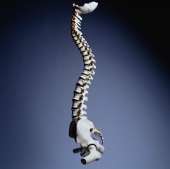Lowest fused vertebral level linked to motion in scoliosis

(HealthDay) -- For postoperative patients with adolescent idiopathic scoliosis (AIS), preservation of vertebral motion segments allows for greater distribution of functional motion, according to a study published in the May 1 issue of Spine.
Michelle Marks, P.T., from Rady Children's Hospital in San Diego, and associates conducted a cross-sectional prospective study of 100 patients with AIS to assess intervertebral segmental and cumulative motion in the distal unfused segments of the spine after instrumentation. Motion was assessed using standardized radiographs and intervertebral angles were measured at each level.
The researchers found that, in lateral bending, there was an association between the lowest fused vertebral level and the degree of motion at the distal unfused segments. There was significantly greater L2-L3, L3-L4, and L4-L5 segment motion with a more distal instrumented vertebrae. There was a similar trend noted at the L5-S1 level. With a more distal fusion, the summed motion from L3 to S1 also increased significantly. These results were not seen with forward bending.
"In a group of two- to five-year postoperative patients with AIS, evaluation of the distal unfused intervertebral motion showed that preservation of a greater number of vertebral motion segments allowed greater distribution of functional motion across the remaining unfused levels," the authors write.
The study was supported by the DePuy Spine fund. One or more authors disclosed financial ties related directly or indirectly to the study subject matter.
More information:
Abstract
Full Text (subscription or payment may be required)
Copyright © 2012 HealthDay. All rights reserved.
















